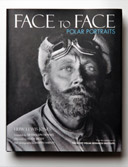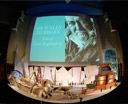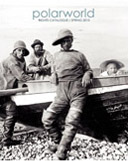 Our ProductsOur Resources |
This website requires the free Flash plugin to be installed.
Polarworld - discover more polar booksThe Arctic Book ReviewMirage in the Arctic Ejnar Mikkelsen Reviewed by Jonathan Dore Despite half-a-dozen arduous expeditions, in which he was twice given up for dead by his family at home, Ejnar Mikkelsen’s name has tended to fade into the footnotes in the grand narratives of Arctic Exploration. At first glance it is not hard to see why: he discovered no new land or route—though not for want of trying—and charted no coastline for the first time. But his many books, if nothing else, are likely to keep his name alive, for they provide an enjoyable encounter with an engaging personality. Fifty-one years after its first publication, Lyons Press have now reissued one of these, Mirage in the Arctic, which covers Mikkelsen’s expedition to search for new land north of Alaska in 1906–08. Reading it gives the Arctic enthusiast a strangely unsettling experience, however: gradually it dawns on one that all the usual landmarks of the genre—the minutiae of dates, names, routes, and directions—are missing. In fact, Mikkelsen had already written another, completely separate book about the expedition, published just a year after returning. Conquering the Arctic Ice (1909) was in the carefully detailed format of the expedition journal, with events dated, distances and temperatures noted, positions calculated, and ethnographic observations recorded. But in retirement 45 years later he was persuaded to let his still-thick hair down and write a lighter, more relaxed account that focused on the expedition as an adventure. (He did the same for the Alabama expedition to East Greenland, complementing 1913’s Lost in the Arctic with 1955’s Two Against the Ice, the latter reprinted by Steerforth in 2003.) Both expeditions’ earlier, fuller accounts are currently out of print, so readers wanting to get the full exploration-journal feel should perhaps be warned of possible disappointment. What they get instead, though, is a delightfully quirky, tongue-in-cheek account of a young man’s folly seen with an old man’s indulgent affection. And folly the older Mikkelsen knew it to be, for by the time he came to write Mirage in the Arctic he knew that the land he had been seeking, and whose existence his younger self was so sure of, did not exist. Though it had been glimpsed by many sober and trustworthy explorers, he then knew that what had beguiled their vision was not solid land but one of the huge ice islands, miles across and more than a hundred feet thick, that periodically break off from the ice caps of Ellesmere Island and Greenland and get caught in the slow vortex of the Beaufort Gyre, making two or three circuits of the Beaufort Sea—each one decades long—before finally breaking up. The awareness of ultimate futility, then, hangs over his description of the young Ejnar desperately trying to raise funds for his grand venture, first in Denmark, then in Britain and the United States, along the way painting amusing portraits of genteel Edwardian society, and the endless ranks of functionaries whose only role, it seemed, was to prevent him from speaking to the New York plutocrats whose money he was after. Queen Alexandra, a fellow Dane, was at first delighted to be patroness of his expedition, but then withdrew when a conflict of interest emerged between another of her roles—patroness of the Royal Society for the Prevention of Cruelty to Animals—and Mikkelsen’s detailed descriptions, reported in the press, of how he planned to feed his dogs to each other to prolong his sledging journey. Touchingly, she passed Mikkelsen on to another, presumably less abstemious aristocrat, the Duchess of Bedford, and he gives an amusing account of a weekend house party at which the no-nonsense duchess first pushes him, in his borrowed tux, towards several likely benefactors, then on the Monday morning not only tells Mikkelsen how much of a tip each servant will be expecting, but surreptitiously hands him the pile of loose change needed to cover it. Once in Victoria, where he fitted out his expedition, he recorded his gratitude by naming his boat Duchess of Bedford, but things went wrong as soon as they sailed. Mikkelsen realized that the small yacht’s unexpectedly large and efficient pump should have given him a clue about its leakiness; he discovered that the boat’s previous owners had a history of sharp business deals that left a lot of people looking to get even, and who might not worry too much about who the boat’s current owner was; and he had a crew who, they frankly admitted once they were too far out to go back, had only signed on to get a free passage to the goldfields near Nome. But he and his co-leader, the American geologist Ernest Leffingwell, plough on, weathering changes of crew and constantly threatening ice, aiming for Herschel Island as their hoped-for wintering spot but making do with Flaxman Island, less far east, when the ice prevents them going further. The following winter, and then the journey northwards onto the ice itself, are dealt with surprisingly swiftly—perhaps knowing that the object of their search was illusory accounts for Mikkelsen’s retrospective reluctance to become too excited about what would, in a standard exploration account, be the high point of the expedition. Instead, we have impressionistic accounts of the varying landscapes of ice that he, Leffingwell and Storker Storkerson passed over, including, unwittingly, sections thick enough to form gentle hills and valleys, broken fragments of the great ice islands they did not yet realize they were seeking. Eventually they could go no further on the supplies available, but at their furthest point from land they took a depth sounding that provided the journey’s most tangible geographical result: the discovery that they were over deep ocean. They had, for the first time, pinpointed the northern edge of the North American continental shelf, and in going beyond it, knew that no new land was likely to be close. The trio returned to land, and to find the Duchess of Bedford crushed in the ice, but we are puzzlingly still only half-way through the book. Leffingwell headed inland to geologize, and others found ships going their way, but Mikkelsen decided he would make his way to an ice-free port on foot. Not south through the mountains, since they were then unmapped and uninhabited, but a journey of three times the distance around the Alaskan coast, where he knew he would at least be able to find food, fresh dogs, and occasional shelter. The major documentary value of Mirage in the Arctic, it emerges, is not about the search for land at all, but in the portrait it offers during this homeward journey of Alaskan society in the strange, confused decade following the Klondike gold rush, when myriad smaller finds all over Alaska each provoked their own, crazed mini-rush, like aftershocks following a great earthquake. As he journeyed west and then south around the coast, he met the entire gamut of gold-rush society, from the richest to the most wretched, but all of them in some way motivated by a mirage as powerful as the one that had attracted Mikkelsen. Whether they sought to mine it directly, wanted to live off those who did, or just wanted to be around it, the whole of white Alaska at that time, in Mikkelsen’s portrait, was obsessed by gold—indeed, the determination needed to have come so far in the first place virtually guaranteed it. At one point he passed three men who symbolized the fatal attraction: they were approaching a mountain pass in a blizzard wearing just their indoor jackets, having set off heedlessly on the rumour of a nearby gold strike. They angrily refused to turn back, though Mikkelsen could see they had only minutes to live. With disarming frankness, Mikkelsen proclaimed his own lack of interest in gold to those he met, and for that very reason came to be regarded with an almost supernatural awe, his reputation preceding him along the trail. In Candle City, a hotel-keeper treated him to a free meal just to enjoy the spectacle of a man unmoved by gold, then wondered if the young Dane was “innocent of women”. It appears that one of the foibles of gold-mining, where success comes through luck, was that a superstition had arisen that an “innocent” Scandinavian was a charmed talisman to anyone hoping to strike gold, and such a man could command a high price for just hanging around a mine giving off an aura of good luck. But the virgin Dane pressed on, and found on arrival at Nome that he was being treated as the city’s guest—whatever he wanted, all expenses were paid. Telegraphing their generosity down the line ensured that his future stops were similarly munificent, as each community vied not to be outdone in lavish hospitality. On the way Mikkelsen paints the portraits of the types he met in the roadhouses: the no-hopers, the old timers cannily misdirecting young naïfs to supposed new gold strikes hundreds of miles away, the silent, single women on their own quest for gold, with determined jaws and prominently displayed firearms, and the vivacious, gaudily dressed single women whose radar immediately found the richest man in the room and hung on until they closed the deal. Despite the hospitality, however, the downside was harsh. While Faulkner’s Reivers fell prey to a suspiciously muddy bend in a Tennessee road from which the only escape was a very expensive tow from the well-placed farmer and his horse, Mikkelsen had to contend with “The Spaniard”, whose services were required to get dog teams up a particularly steep stretch of trail. The Spaniard’s secret, strangely, was just a slightly larger whip and a vocabulary of Iberian invective that seemed to scald dogs into action, though he demanded top dollar to use it. And while the great and the good of Fairbanks turned out to offer Mikkelsen all the luxuries money could buy, they wouldn’t let his travelling companion of several days have so much as single free drink; dinner conversation later revealed that Mikkelsen was the only one among them without a user’s knowledge of the federal jail system. The Arctic Candide’s journey finally comes to an end at Valdez, and after a minor shipwreck on the way, he rejoins civilization, dropping off a $40,000 bag of gold he had been absent-mindedly carrying for a Nome businessman to a business partner in Seattle. By the time he reaches Puget Sound, a journey in search of new land seems like a rather distant memory. Is that what he had gone for? It is hard to say—but it is not hard to tell which part of his picaresque romp he had most relished. |
|
||
follow us  | join us | join us  | home | contact | home | contact
|
||||
|
© Copyright Polarworld Ltd
SiteWizard.co.uk Web Site Design Company |
||||


